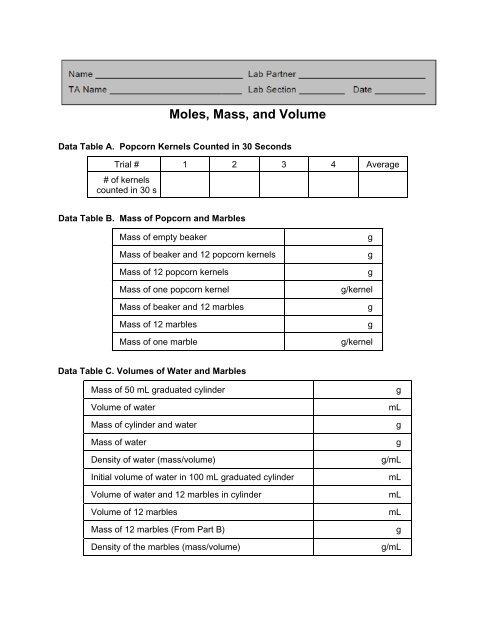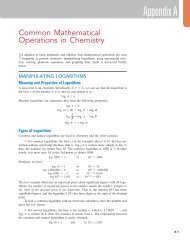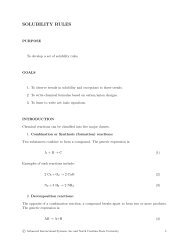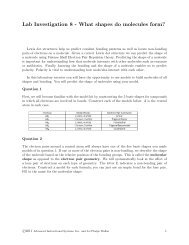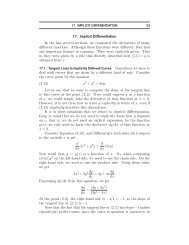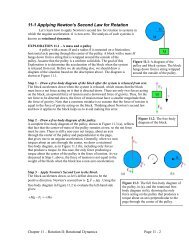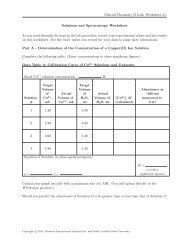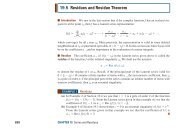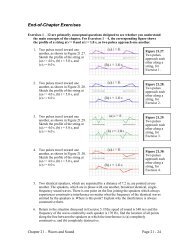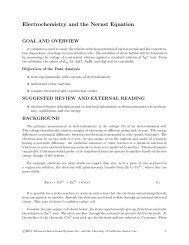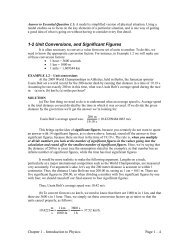General Chemistry I Worksheets - WebAssign
General Chemistry I Worksheets - WebAssign
General Chemistry I Worksheets - WebAssign
Create successful ePaper yourself
Turn your PDF publications into a flip-book with our unique Google optimized e-Paper software.
Moles, Mass, and VolumeData Table A. Popcorn Kernels Counted in 30 SecondsTrial # 1 2 3 4 Average# of kernelscounted in 30 sData Table B. Mass of Popcorn and MarblesMass of empty beakerMass of beaker and 12 popcorn kernelsMass of 12 popcorn kernelsMass of one popcorn kernelMass of beaker and 12 marblesMass of 12 marblesMass of one marblegggg/kernelggg/kernelData Table C. Volumes of Water and MarblesMass of 50 mL graduated cylinderVolume of waterMass of cylinder and waterMass of waterDensity of water (mass/volume)Initial volume of water in 100 mL graduated cylinderVolume of water and 12 marbles in cylinderVolume of 12 marblesMass of 12 marbles (From Part B)Density of the marbles (mass/volume)gmLggg/mLmLmLmLgg/mL
Flame TestsData Table A. Flame tests results of known and unknown salt solutionsCompoundbarium chloride, BaCl 2Color of FlameIon Responsible for FlameColorbarium nitrate, Ba(NO 3 ) 2calcium chloride, CaCl 2calcium nitrate, Ca(NO 3 ) 2copper(II) chloride, CuCl 2copper(II) nitrate, Cu(NO 3 ) 2lithium chloride, LiCllithium nitrate, LiNO 3potassium chloride, KClpotassium nitrate, KNO 3sodium chloride, NaClsodium nitrate, NaNO 3strontium chloride, SrCl 2strontium nitrate, Sr(NO 3 ) 2Unknown # _________Unknown # _________Question 1. Which ion emitted the higher energy photons in the visible region: Cu 2+ or Sr 2+ ?Explain your answer.
Question 2. Which ion emitted photons with the longer wavelength in the visible region: Li 1+ orNa 1+ ? Explain your answer.Question 3. Which ion emitted the lower frequency photons in the visible region: Ba 2+ or K 1+ ?Explain your answer.Question 4. The brilliant red color in fireworks is often due to the emission of red light from Sr 2+ .If the primary wavelength is 650 nm, what is the frequency of this light?Question 5. From the data collected and the information gained in lecture, would the anionhave a dramatic effect on the color of the light emitted? Explain your answer.
Solubility RulesData Table A. Investigating Trends in SolubilityNH 41+K 1+ Ca 2+ Sr 2+ Mg 2+ Al 3+ Fe 3+ Zn 2+Cl 1–ClO 41–OH 1–CO 32–SO 42–PO 43–Additional Observations:Question 1. In general, are compounds containing ammonium ions or ions from Group 1 onthe Periodic Table soluble or insoluble?Question 2. What exceptions did you find to the Group 1 rule?Question 3. Are compounds containing an ion with either a +1 or a –1 charge soluble orinsoluble?
Question 4. What exceptions did you find to the charge rule?Question 5. In general, are compounds containing the carbonate anion soluble or insoluble?Question 6. What exceptions did you find to the carbonate ion rule?Question 7. In general, are compounds containing the sulfate anion soluble or insoluble?Question 8. What exceptions did you find to the sulfate ion rule?Question 9. In general, are compounds containing the phosphate anion soluble or insoluble?Question 10. What exceptions did you find to the phosphate ion rule?Question 11. Considering the general rules you found for Group 1 ions and phosphate ion,which rule takes precedence?Question 12. State a general rule that relates the solubility of an ionic compound with thecharges on the ions of which it is composed.
Question 13. In your Data Table A, write the chemical formula for any compound thatprecipitated. Pay attention to charges on the ions; the number of positive chargesin the formula should equal the number of negative charges.Question 14. Write balanced net ionic equations for reactions that produced a precipitatecontaining magnesium ion, (Mg 2+ ).Data Table B. Investigating Some Exceptions to the Solubility RulesAg 1+ Pb 2+Cl 1–Additional Observations:Question 15. What exceptions did you observe by mixing Ag 1+ with Cl 1– and Pb 2+ with Cl 1– ?Question 16. In your Data Table B, write the chemical formula for any compound thatprecipitated. Pay attention to charges on the ions; the number of positive chargesin the formula should equal the number of negative charges.Question 17. Write balanced net ionic equations for reactions that produced a precipitate inData Table B.
Qualitative AnalysisData Table A. Confirmatory Tests for Individual Ions*Ion Part Solution Results of adding KI solution*A Well plate solutionB Solution from HClBSolution from hot waterBASolution from ammoniaWell plate solutionHg 22+BBSolution from HClSolution from hot waterBSolution from ammoniaA Well plate solutionB Solution from HClBSolution from hot waterBSolution from ammonia*If there was a precipitate, rather than a clear solution, fill in this space with “NA”.
Data Table B. Solubility of Individual IonsSoluble in HClAg 1+ Hg 22+Pb 2+Soluble in hot waterSoluble in ammoniaQuestion 1. Which ions, if any, can you separate by their solubility in HCl?Question 2. Which ions, if any, can you separate by their solubility in hot water?Question 3. Which ions, if any, can you separate by their solubility in NH 3Question 4. How do your results from the confirmatory tests in Part A compare with theconfirmatory tests performed on the solutions from individual ions in Part B? Canthe observations be used to determine which ions are present in solution?Question 5. Complete the flow chart below for the known solutions. It will serve as a referenceas you test your separation scheme. At each branch in the flow chart, you shouldlist the ions that exist as solid compounds on the left, under the label “insoluble.”List ions that exist in solution on the right, under the label “soluble.” There shouldbe from zero to three entries on each line. At the end, the ions should be separatedand each of the three ions should be present at different places on the flow chart.
Figure 1. Flow Chart for Separation of Mixture of Ag 1+ , Hg 2 2+ , Pb 2+Ag 1+ , Hg 2 2+ , Pb 2+insolubleHClsolublehot waterinsolublesolubleinsolubleNH 3solubleEach “soluble” branch should be tested with KI to confirm the presence of an ion.Data Table C1. Solubility of a Mixture of Ag 1+ , Hg 2+ 2 , Pb 2+Mixture of Ag 1+ , Hg 2+ 2 , Pb 2+Soluble in HClSoluble in hot waterSoluble in ammoniaData Table C2. Confirmatory Tests for Ions in Mixture of Ag 1+ , Hg 2 2+ , Pb 2+SolutionResults of adding KI solutionSupernatant from HCl additionSupernatant from hot waterSupernatant from ammonia
Question 6. Based on your confirmatory tests, describe where the soluble ions ended up. Werethey where your flow chart predicted?Data Table D1. Solubility of Unknown Mixture #Unknown MixtureSoluble in HClSoluble in hot waterSoluble in ammoniaData Table D2. Confirmatory Tests for Ions in Unknown MixtureSolutionResults of adding KI solutionSupernatant from HCl additionSupernatant from hot waterSupernatant from ammoniaQuestion 7. Unknown # _______ contained the following ions: ____________ .
Molecular GeometryData Table A. Exploring Simple StructuresMoleculesN 2 OSO 2CH 2 OBondLengths (Å)NN:NO:SO:SO:CO:CH:CH:Bond OrdersNN:NO:SO:SO:CO:CH:CH:Bond Angles( )Hybridizationon CentralAtomMolecularShapeH 2 ONH 3CH 4OH:OH:NH:NH:NH:CH:CH:CH:CH:OH:OH:NH:NH:NH:CH:CH:CH:CH:Question A1. For each of the six molecules, how did your Lewis structures compare to themolecular models and the models on the computer? Were they the same ordifferent? Explain.Question A2. For each of the six molecules, was your Lewis structure a good and accuraterepresentation of the molecule’s actual shape? Explain why or why not.
Question A3. Did the model set and computer models help you identify the molecular shapebetter than the Lewis structures? Do you think models are helpful with 3Dvisualization?Question A4. Did you have any other interesting observations? Please elaborate.Data Table B: Bond Order vs Bond LengthMoleculesBond Lengths(Å)C 2 H 6 CC: CC:Bond OrdersHybridizationon CarbonsC 2 H 4 CC: CC:C 2 H 2 CC: CC:Question B1. What conclusions can you draw about bond order and bond length?Question B2. Looking back at your data in Part A, are all single bonds the same length?Based on these observations, can you make a generalization about the length ofall single bonds compared to double bonds or all double bonds compared totriple bonds? What general rule can you make?
Question B3. Did you have any other interesting observations? Please elaborate.Data Table C:MoleculesC 6 H 6CO 32-SCN 1-Resonance StructuresBondLengths (Å)CC:CC:CC:CC:CC:CC:CO:CO:CO:CS:CN:Bond OrdersCC:CC:CC:CC:CC:CC:CO:CO:CO:CS:CN:Bond Angles( )CCC:HybridizationC’s:OCO: C:SCN: C:Question C1. Which of the three molecules had resonance structures that were equal? Whichdid not? Explain.Question C2. How can you confirm that the resonance structures are equal for a molecule?Explain.
Question C3. If there was a molecule with unequal resonance structures, which structure is thebest according to the computer modeling? Can you tell which structure thecomputer is displaying? How? Do your observations agree with what you havelearned about formal charge?Question C4. Did you have any other interesting observations? Please elaborate.
Solid State ModelingQuestion A1. Looking from above, how much of the atom is inside the shaded region?Question A2. The corner of a cubic unit cell such as this one is defined by the center (nucleus)of the atom at the corner. How much of this atom is above the nucleus andinside the shaded region (inside the unit cell)?Question A3. How many total atoms are inside the unit cell (defined by the centers of the eightspheres)?Question A4. Using a ruler, measure the length of a side of your unit cell in cm. (Remember,the unit cell is defined by the nuclei of the atoms!) What is the volume of yourunit cell?Question A5. We will define “atom density” for our unit cells as the number of spheres that canpack into a cubic centimeter. What is the “atom density” (spheres/cm 3 ) for yoursimple cubic cell?Question A6. Noting as before that the corner of the unit cell is defined by the nucleus of thisatom, how much of this atom is inside the unit cell?Question A7. Focus on the layer 2 atom. How much of this atom is inside the unit cell?Question A8. How many total atoms are inside the unit cell?
Question A9. Using a ruler, measure the length of a side for this unit cell. What is the volume(in cm 3 ) of this unit cell?Question A10. What is the “atom density” (spheres/cm 3 ) for your body centered cubic cell?Question A11. a. Comparing this structure (body centered cubic) to the last structure (simplecubic), which one appears to have less void volume?b. Compare your observation to your calculated “atom densities” for these twostructures. Do your calculations confirm your observation?Question A12. Focus on a layer 2 atom. How much of this atom is inside the unit cell?Question A13. How many total atoms are inside the unit cell?Question A14. Using a ruler, measure the length of a side of this unit cell. What is the volume(in cm 3 ) of this unit cell?Question A15. What is the “atom density” (in spheres/cm 3 ) for your face centered cell?
Question A16. a. Comparing this structure (face centered cubic) to the last structure (bodycentered cubic), which one appears to have less void volume?b. Compare your observation to your calculated “atom densities” for these twostructures. Do your calculations confirm your observation?Question A17. Comparing the “atom densities” of all three cubic unit cells, rank them in packingefficiency, with the most efficiently packed cell listed first.Question B1. Focus on only the colorless spheres.appear to be arranged in?What type of cubic structure do theyQuestion B2. Focus on only the blue spheres. What type of cubic structure do they appear tobe arranged in? (You may need to build another set of layers 2 and to seethis.)Question B3. a. How many colorless spheres are inside the unit cellb. How many blue spheres are inside the unit cell?c. What is the ratio of colorless to blue spheres in the unit cell?d. What is the chemical formula for sodium chloride?e. Do your results in part c reflect the correct stoichiometry in sodium chloride?f. Based on your knowledge of trends in ionic radii, which spheres representsodium ions and which represent chloride ions?Question B4. a. Focus on the central, colorless sphere of layer 1’. How many blue spheresare in contact with it? (You may need to build another set of layers 2 and tosee this.) This is its coordination number.b. Focus on the central, blue sphere of layer . How many colorless spheresare in contact with it?
Question B5. Focus on only the colorless spheres.appear to be arranged in?What type of cubic structure do theyQuestion B6. a. How many colorless spheres are inside the unit cell?b. How many green spheres are inside the unit cell?c. What is the ratio of colorless to green spheres in the unit cell?d. What is the chemical formula for cesium chloride?e. Do your results in part c reflect the correct stoichiometry in cesium chloride?f. Based on your knowledge of trends in ionic radii, which spheres representcesium ions and which represent chloride ions?Question B7. Focus only on the cube made by the 8 green spheres.a. What type of cubic structure do the green spheres appear to be arranged in?b. What is the ratio of colorless to green spheres?Question B8. Using a ruler, compare the length of the side of a cube with colorless spheres onthe corners to one with green spheres.a. Do they have the same volume?b. Are these both acceptable unit cells for cesium chloride? Why or why not?Question B9. a. Focus on one of the green spheres in layer . How many colorless spheresare in contact with it?b. Focus on the colorless sphere at the center of the green cornered cube. Howmany green spheres are in contact with it?
Question B10. a. Focus on only the colorless spheres. What type of cubic structure do theyappear to be arranged in?b. Focus on only the green spheres. What type of cubic structure do theyappear to be arranged in?Question B11. Putting the two ions together in this arrangement gives the “fluorite” structure.The name is derived from the mineral fluorite, which contains calcium fluoride.a. How many colorless spheres are inside the unit cell?b. How many green spheres are inside the unit cell?c. What is the ratio of colorless to green spheres in a unit cell?d. What is the chemical formula of calcium fluoride?e. Do your results in part c reflect the correct stoichiometry in calcium fluoride?f. Which spheres represent calcium ions and which represent fluoride ions?
Measuring Enthalpy ChangesData Table A. Heat of SolutionInitial temperature of waterTemperature of solution after addition to CaCl 2T 1A (T final – T initial ) for dissolution of CaCl 2Initial temperature of waterTemperature of solution after addition to NH 4 NO 3T 2A (T final – T initial ) for dissolution of NH 4 NO 3CCCCCCQuestion 1. For dissolution of CaCl 2 , please answer a – c.a. Was heat given off or absorbed? Could you feel it?b. Was the process exothermic or endothermic?c. Did the entropy increase, decrease, remain the same or can you not tell fromyour results?Question 2. For dissolution of NH 4 NO 3 , please answer a – c.a. Was heat given off or absorbed? Could you feel it?b. Was the process exothermic or endothermic?c. Did the entropy increase, decrease, remain the same or can you not tell fromyour results?Question 3. Which chemical would you use in a cold pack, CaCl 2 or NH 4 NO 3 ?
Data Table B. Heat of ReactionInitial FeCl 3 solutionSolution after addition of NaOHT 1BTemperatureCCCObservationsQuestion 4. For the reaction of FeCl 3 and NaOH, please answer a – d.a. What evidence indicates that a reaction occurred?b. Did the reaction give off or absorb heat? Could you feel it?c. Did the entropy increase, decrease, remain the same or can you not tell fromyour results?d. Was the reaction spontaneous? Justify your answer.Data Table C. Heat of NeutralizationInitial NaOH solutionsSolution after addition of waterT 1CSolution after addition of HClT 2CSolution after addition of HNO 3T 3CSolution after addition of HC 2 H 3 O 2T 4CTemperatureCCCCCCCCCObservations
Question 5. In which test tubes was there evidence for a reaction?Question 6. a. Were the temperature changes about the same or very different for thereactions?b. Can you account for this result? Hint: write the reaction equations and comparethem.Question 7. Did the entropy increase, decrease, remain the same or can you not tell from yourresults?Data Table D. Temperature and time during the heating of waterElapsedtime, minTemp,CObservationsElapsedtime, min0.0 8.00.5 8.51.0 9.01.5 9.52.0 10.02.5 10.53.0 11.03.5 11.54.0 12.04.5 12.55.0 13.05.5 13.56.0 14.06.5 14.57.0 15.07.5 15.5Temp,CObservations
Question 8. a. Were there times when the temperature stayed constant for several readings?b. What was happening during these times?Question 9. What happened to the entropy of the system for each of the following processes?Did it increase greatly, increase slightly, decrease greatly, decrease slightly, staythe same or can you not tell from your results?a. As the ice melted?b. As the water was heated?c. As the water boiled?
Graph Paper (Please substitute with HM graph paper.)
Equilibrium and Le Châtelier’s PrincipleData Table A. Observations for the Equilibrium:Fe 3+ + SCN 1– ⇌ FeSCN 2+Well # Stress Applied Observations Upon Applying Stress1None; control forcomparison2 Add 0.10 M Fe(NO 3 ) 33 Add 0.05 M NaSCN4 Add 1.0 M AgNO 35 Add 1.0 M NaNO 3Question 1. When Fe(NO 3 ) 3 was added to the system,a. Which ion in the equilibrium system caused the “stress”?b. Which way did the equilibrium shift?c. What happened to the concentration of SCN 1– ?d. What happened to the concentration of FeSCN 2+ ?Question 2. When NaSCN was added to the system,a. Which ion in the equilibrium system caused the “stress”?b. Which way did the equilibrium shift?
c. What happened to the concentration of Fe 3+ ?d. What happened to the concentration of FeSCN 2+ ?Question 3. When AgNO 3 was added to the system, it caused the precipitation of solid AgSCN.a. Which ion in the equilibrium had its concentration changed by addition ofAgNO 3 ?b. Did the concentration of that ion increase or decrease?c. When AgNO 3 was added, which way did the equilibrium shift?Question 4. When you added NaNO 3 , did anything happen? Can you explain this result?Data Table B. Observations for the Equilibrium:CoCl 4 2– + 6H 2 O ⇌ Co(H 2 O) 6 2+ + 4Cl 1–Exp’t Stress Applied Observations Upon Applying StressWell 1AAdd 12 M HClWell 1BAdd waterWell 2AAdd 12 M HClWell 2B Add 1.0 M AgNO 3Beaker 1Heat SolutionBeaker 2Cool Solution
Question 5. Adding HCl has the effect of adding Cl 1– ions to the system. When Cl 1– was addedto the system,a. Which way did the equilibrium shift?b. What happened to the concentration of CoCl 4 2– ?c. What happened to the concentration of Co(H 2 O) 6 2+ ?Question 6. When water was added to the system,a. Which way did the equilibrium shift?b. What happened to the concentration of CoCl 4 2– ?c. What happened to the concentration of Co(H 2 O) 6 2+ ?Question 7. When you added AgNO 3 , it caused the precipitation of solid AgCl.a. Which ion in the equilibrium had its concentration changed by addition ofAgNO 3 ?b. Did the concentration of that ion increase or decrease?c. When AgNO 3 was added, which way did the equilibrium shift?Question 8. State a general rule concerning a system at equilibrium when more of one of thecomponents is added.Question 9. State a general rule concerning a system at equilibrium when one of thecomponents is removed.
Question 10. For the CoCl 4 2– + 6H 2 O ⇌ Co(H 2 O) 6 2+ + 4Cl 1– Equilibrium,a. Which way did the equilibrium shift upon heating?b. Which way did the equilibrium shift upon cooling?c. A general rule concerning temperature changes to equilibrium systems is thatthe input of energy (raising the temperature) shifts the equilibrium to the higherenergy side of the equilibrium. Based on your observations, which side of theequilibrium is the higher energy side?2–d. Is the reaction, CoCl 4exothermic?+ 6H 2 O ⇌ Co(H 2 O) 6 2+ + 4Cl 1– endothermic or
TitrationsData Table A1. Titration of VinegarTrial 1 Trial 2 Trial 3Mass of Flask g g gVolume of Vinegar mL mL mLMass of Flask + Vinegar g g gMass of Vinegar g g gConcentration of NaOH M NA NAInitial Buret Reading mL mL mLFinal Buret Reading mL mL mLVolume of Titrant Added mL mL mLQuestion 1. Calculate the number of millimoles of NaOH required to reach the endpoint foreach trial. Show one calculation completely. What is the average? Record thevalues in Data Table A2.Question 2. How many millimoles of acetic acid are in each vinegar sample? Show onecalculation completely. What is the average? Record the values in Data Table A2.
Question 3. What is the mass of acetic acid in each vinegar sample? Show one calculationcompletely. What is the average? Record the values in Data Table A2.Question 4. What is the molarity of acetic acid in each vinegar sample? Show one calculationcompletely. What is the average? Record the values in Data Table A2.Question 5. What is the mass % of acetic acid in each vinegar sample? Show one calculationcompletely. What is the average? Record the values in Data Table A2.Data Table A2. Calculation Results for Titration of Vinegarmmol of NaOHTrial 1 Trial 2 Trial 3 Averagemmol of HC 2 H 3 O 2Mass of HC 2 H 3 O 2 g g g gMolarity of HC 2 H 3 O 2 inVinegarMass % of HC 2 H 3 O 2 inVinegarM M M M
Acid-Base StudiesData Table A. pH Measurements of Some Common Acid and Base Solutions.Solution # Solution pH1 0.10 M HCl2 0.010 M M HCl3 0.0010 M M HCl4 0.10 M HC 2 H 3 O 25 0.10 M NaOH6 0.010 M NaOH7 0.10 M NH 3Question 1. Based on your observations in Data Table A, classify each of the following as astrong acid, strong base, weak acid or weak base.a. HClb. HC 2 H 3 O 2c. NaOHd. NH 3Question 2. a. What happened to the pH when the 0.10 M HCl was diluted to 0.010 M?b. What happened to the pH when the 0.10 M NaOH was diluted to 0.010 M?c. State a general rule about what happens to the pH of acidic or basic solutionswhen they are diluted with pure water.
Data Table B. Acidity and Basicity of Some Household ChemicalsSubstance pH Acid, Base, or NeutralVinegarBleachVitamin CLemon JuiceBaking SodaDishwasher DetergentCarbonated waterBaking PowderAmmoniaQuestion 3. a. List all of the household chemicals that you found to be acidic.b. List all of the household chemicals that you found to be basic.c. List all of the household chemicals that you found to be neutral.Data Table C. HCl + NaOHmL NaOH0.03.06.012.0pHQuestion 4. Based on your observations in Data Table C, classify each of the resultingsolutions as acidic, basic or neutral.a. HCl + 0.0 mL NaOHb. HCl + 3.0 mL NaOHc. HCl + 6.0 mL NaOH
d. HCl + 12.0 mL NaOH
Redox ReactionsData Table A1. Reactions of Oxidizing AgentsCu 2+ Mg 2+ 1–MnO 4H 2 O 2KIQuestion 1. List the oxidizing agents in order, from weakest to strongest.Question 2. Write half-reactions for the oxidizing agents in order, from weakest to strongest.(Hint: Remember that oxidizing agents get reduced.)Data Table A2. Reactions of Reducing AgentsCu Mg ZnH 2 OH 3 O 1+Question 3. List the reducing agents in order, from strongest to weakest.Question 4. Write the half-reactions for the reducing agents in order, from weakest to strongest.(Hint: Remember that reducing agents get oxidized.)
Question 5. The strongest oxidizing agent is said to have the most positive potential and thestrongest reducing agent has the most negative potential. Based on yourobservations, list all the half-reactions (as reductions) in order from most negativeto most positive.Question 6. Consider the reaction involving magnesium metal.a. With what compound, element or ion did magnesium react?b. Write a half-reaction for what happened to this chemical. You may use a Tableof Standard Reduction Potentials on the inside cover of the lab manual for help.c. Write the balanced equation for the reaction that occurred between magnesiummetal and this chemical.Question 7. You also observed a reaction with zinc metal.a. With what compound, element or ion did zinc react?b. Write a half-reaction for what happened to this chemical. You may use a Tableof Standard Reduction Potentials on the inside cover of the lab manual for help.c. Write the balanced equation for the reaction that occurred between zinc metaland this chemical.
Question 8. Based on your answers to Question 5, will either of these combinations produce areaction?a. Cu + Mg 2+b. Cu 2+ + MgData Table B1. Cell Potentials vs a Cu 2+ /Cu CoupleElectrochemicalCellCopper-CopperHalf-CellBeingStudiedCu 2+ /CuMeasured PotentialDifference vs Cu 2+ /Cuin mVMeasured PotentialDifference vs Cu 2+ /Cuin VSilver-CopperLead-CopperZinc-CopperAg 1+ /AgPb 2+ /PbZn 2+ /ZnData Table B2. Cell Potentials in Order, with Half-ReactionsHalf-CellMeasured CellPotential(Most negative tomost positive)Calculated CellPotential vs SHE(Add +0.34 V)Standard ReductionPotential vs SHEfrom TableV V VV V VV V VV V VQuestion 9. Based on the order obtained by experiment,a. Which species has the highest energy filled or partially filled orbitals?b. Which species has the lowest energy unfilled or partially filled orbitals?c. Which species is the strongest reducing agent?d. Which species is the strongest oxidizing agent?
Question 10. Using the order you found in Data Table B2 for the cell potentials, write the halfreactionfor each half-cell. Write the reactions as reductions.Question 11. The Mg 2+ /Mg couple was not tested when measuring half-cell potentials. Based onits behavior in Part A, where would you place it in Data Table B2? (If you are doingPart B first, return to this question after completing both parts of the lab.


